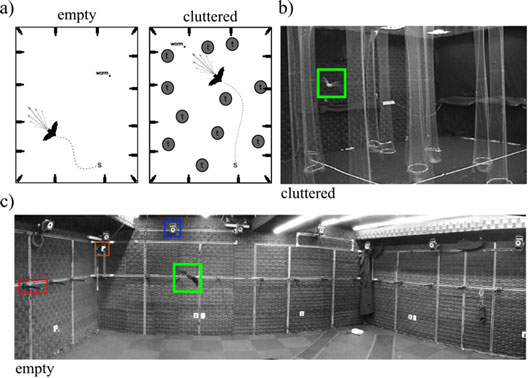The big brown bat (Eptesicus fuscus) is a small echolocating bat, native to Northern America, that commonly forages for insect prey in open areas, close to water surfaces or vegetation. It captures small insects by sending out high frequency sonar sounds that impinge on the prey and return echoes, which tell the bat about the insect’s size, shape and position in space. Each echolocation signal a bat produces may result in a cascade of echoes from objects at different locations in its surroundings, which can also mix with the echolocation signals from other bats in the vicinity. The bat must therefore sort echoes from its own signals arriving from different objects and from signals produced by neighboring bats. We refer to this challenge as a bat cocktail party nightmare, referencing the human cocktail party problem of processing information from one conversation in the midst of many other conversations. Indeed, the bat’s challenge may be analogous to attempting to have a conversation at a crowded rock concert, as bat echolocation sounds are often as loud as jet engines on an airport runway.
In order to solve the cocktail party nightmare, each bat needs to discriminate between the echoes returning from its own calls and signals and echoes of other bats’ calls. Previous research has shown that the big brown bat changes the structure of its sonar signal design, depending on how much it differs from the call structures of neighboring bats. It has been further demonstrated that bats in an open environment may even stop echolocating, go silent, and possibly eavesdrop on other bats while they forage. No studies, however, have evaluated how groups of bats manage to navigate through cluttered environments, such as a forest, as they commonly do.
Using multimedia high-speed video and sound recordings, we investigated how pairs of bats adapt their sonar vocalizations and flight behavior in open and cluttered flight spaces. We hypothesized that bats would continue to make changes to their call structure in both environments. However, we also hypothesized that bats would not show silent behavior in a cluttered flight space, as they not only have to monitor where the other bat is, but also cope with echoes returning from obstacles (artificial trees in this experiment).
Our findings demonstrate that bats dynamically adjust the frequency content of their calls, both in open and cluttered flight spaces. However, we did not find evidence for silent behavior in the artificial forest, and surprisingly, in the open flight space, as had been reported in earlier research. Further investigation into the data set revealed a difference in the subject composition between our recent study and an earlier one reporting silent behavior, namely the bats in our recent study were entirely female, and the bats in the previous study were mostly all male. Flight behavior of male bat pairs in the previous research showed patterns reminiscent of following or chasing, and it was typically the trailing male that showed silent behavior. In our recent study, female pairs rarely engaged in following flight and produced echolocation calls more continuously from separate regions of the experimental test room. These findings provide fertile ground for future studies on the behavioral and gender differences in echolocating bats.

Figure: Experimental setup for the study reported in Brain, Behavior and Evolution. a) top-view schematic of the flight room (7 x 6 x 2.5 m, L x W x H) where bats searched for tethered insects in an empty room (left) and cluttered room (right). High speed motion-capture cameras and two high resolution IR video cameras were mounted around the perimeter of the room to record the bat’s flight and reconstruct its trajectory (grey dotted line) as it searched for a tethered worm (black dot labeled worm). The bat's broadcast is depicted with grey arrows. Schematic shows only a single bat, but they also flew in pairs. b) Photograph of flight room in cluttered condition. Bat highlighted in green box. c) Photograph of the empty room. Bat highlighted in green box, microphone in red box, high resolution high speed video camera in brown box, and high speed IR motion capture camera in blue box.
Reference
Active listening in a bat cocktail party: Adaptive echolocation and flight behaviors of big brown bats, Eptesicus fuscus, foraging in a cluttered acoustic environment. Warnecke, M., Chiu, C., Engelberg, J. and Moss, C.F. Brain Behavior Evolution, Special Issue on the Neurobiology and Behavior of Predators and Prey, 2015, 86: 6–16, DOI: 10.1159/000437346.


































